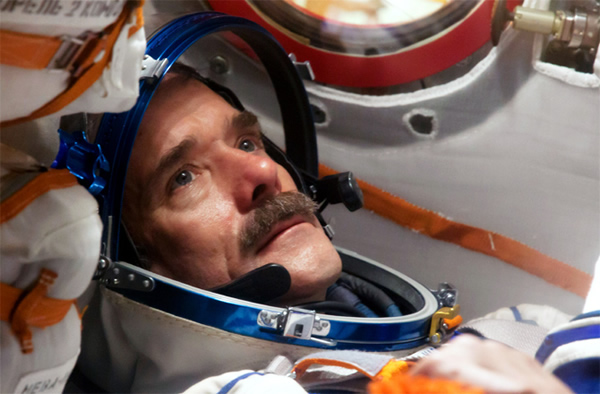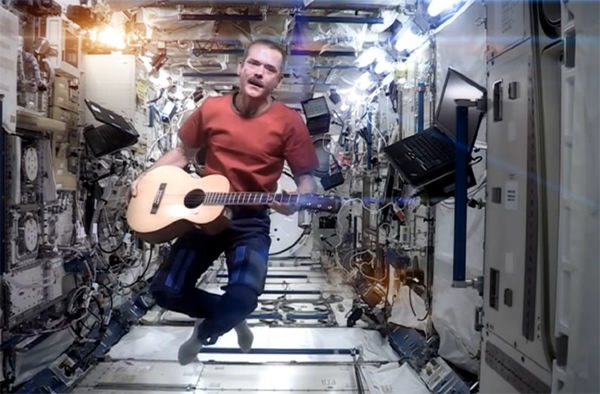Chris Hadfield: DNews Person Of The Year
Expedition 34 Flight Engineer Chris Hadfield of the Canadian Space Agency conducts a "fit check" dress rehearsal inside the Soyuz TMA-07M spacecraft Dec. 7, 2012, before his launch to the International Space Station with Russian cosmonaut Roman Romanenko NASA astronaut Tom Marshburn.
Chris Hadfield performs David Bowie's "Space Oddity" on the International Space Station in May 2012.
Colonel Chris Hadfield is a man of firsts. He was the first Canadian to carry out a spacewalk, the first Canadian to command the International Space Station and the first person in history to record a produced music video in space. Because of his unique ability to captivate the world, bringing a focus on space station science and what it’s like to live in space, Discovery News is proud to announce that Hadfield has been selected as the first DNews Person of the Year!
Few would question Hadfield’s popularity. He was already known by millions as an astronaut who loves to share his experiences in orbit. He undoubtedly cemented his cosmic fame when he released the first authentic space music video -- a cover of David Bowie’s “Space Oddity” -- in May 2013 during the final days of his tenure as space station commander.
After returning to Earth on May 13 and retiring from his astronaut career of 21 years, the 54 year-old Ontario native moved back to Canada to begin a new chapter of his life. Inundated by requests for speaking engagements, book tours and even a new job as adjunct professor at the University of Waterloo, could Hadfield’s retirement actually be busier than when he was an astronaut?
“People say that, and it makes me laugh!” Hadfield told me over the phone. “People have no idea how busy and demanding the life of an astronaut is.”
After more than two decades working as an astronaut (and a Royal Canadian Air Force pilot before that), Hadfield gave me a small taste of the duties that were expected of him as a Canadian space man, culminating in an epic five month adventure on the orbiting outpost. Between the endless study, preparation, working with other astronauts and various leadership roles, very little time was left.
But the world is most familiar with Hadfield’s ability to share his experiences using all the tools at his disposal, most notably through his Twitter account @Cmdr_Hadfield. He became so effective at communicating with the world during Expedition 35 that the public had a very warped view on how much time he spent on Twitter.
“I think people get a kind of misperception about the amount of time that I was putting into social media,” he said. “It’s so simple to send a tweet. I’m taking photos regardless, all astronauts do, and I think I took 45,000 photographs in the five months on the space station. Once you get in the Cupola, who wouldn’t!”
The Cupola, a European-built module of the ISS where astronauts have an uninterrupted view of the Earth, was often used by Hadfield for some terrestrial photography, as well as a location to contemplate the orbital experience.
“To a large degree, that is what had the biggest impact -- just a couple of minutes every day in amongst the 24 hours that I worked, most of them,” Hadfield continued. “So it was by no means the focus of what I did; the space station is a big, complex scientific laboratory and a complex structure that took a lot of work, but I’d try to send pictures of it on a daily basis and not just keep (the experience) to myself.”
Hadfield attributes his ability to connect with the world through social media as being behind his promotion to a household name.
“It’s enabled completely by technology. The beauty of social media is in the first word: it’s social,” he said. “This is a huge difference (from traditional media). Instead of telling people what we are doing on the space station, you can invite them on board to share what we are doing on the space station.”
Commending NASA and the Canadian Space Agency, Hadfield pointed out that very little of the outreach he did would have been possible if it weren’t for the space agencies’ foresight to enable the technology on the ISS.
Though certainly not the first to showcase experiments on the space station, Hadfield -- with his unique “bent” on teaching -- became very well known for some key demonstrations he videoed, to the delight of his growing fan base. From what happens when you cry in space, to the physics of water surface tension when you wring a wet tea towel in microgravity, every video became a Youtube sensation.
“It’s something that I was resolved to do since I was nine -- if I get to (go into space), I want to share it and show folks what it’s really like,” Hadfield explained. “I tried to do it on the previous two flights, but I was limited by the technologies that existed.”
Hadfield’s previous spaceflight missions included STS-74, a shuttle Atlantis mission to the Russian Mir space station in November 1995, and STS-100, an Endeavour mission to the International Space Station to install the Canadarm2 robotic arm in April 2001. It was during the latter mission that he became the first Canadian to complete a spacewalk.
Then, on Dec. 19, 2012, he launched in the Russian Soyuz TMA-07M spacecraft to begin his long-duration stay as a part of Expedition 35 with NASA astronaut Thomas Marshburn and cosmonaut Roman Romanenko. When he took command (after the Expedition 34 crew departed the station in March 2013), it was only the second time that neither a NASA astronaut nor Russian cosmonaut was in command of the ISS.
During his stay on the space station, Hadfield was responsible for the lives of five other crewmembers and helped to run dozens of scientific experiments; he also oversaw the berthing of the second SpaceX commercial cargo run.
Through his expert social media skills, he quickly amassed a huge number of followers. So, ending his mission on a high note, the talented astro-musician combined his passion for space with his passion for music and starred in the first professionally-crafted music video shot in space.
Taking on the roles of “Ground Control” and “Major Tom,” Hadfield sung the David Bowie classic “Space Oddity,” a video that will be forever cemented in spaceflight history. But why did he choose to do it?
“I was just trying to be a good dad!” Hadfield said with a laugh. “I mean really, at the start, my son was insistent. He was like ‘Dad, you have to do this, everyone wants you to do it!’ It was one of those ‘Right, OK, I’ll try to squeeze it in’ projects.”
Working with friends and fellow Canadians Emm Gryner, an award-winning musician, and Joe Corcoran, a music producer based in LA, Hadfield crafted the vocals. Then his son Evan urged him to record the now-famous music video.
“'Space Oddity' really (came about) because my son was insistent ... and he was right. The worldwide response was phenomenal and continues to be.”
By this point, Hadfield had reached a million followers on Twitter and had garnered a huge following on Reddit, Tumblr and Facebook (to name just a few social networks), but being in space meant that he wasn’t fully aware of how his popularity on the ground had skyrocketed.
“I wasn’t all that aware ... Once in a while I’d get a tweet from William Shatner or from another celebrity and that was kind of delightful,” he said. “It was like ‘Hey, other people are paying attention to what we are doing!’ but I think that that is the slice that people see, they thought that was the priority of what I was doing.”
Despite the huge social media following Hadfield still enjoys, it is still the tangible, everyday experiences that he holds most dear.
“The scope of the response is wonderful. It’s been really delightful for me. Everywhere that I go I am stopped by people that I’ve never met telling me that they’re proud of me. I don’t know of a bigger complement or privilege – no matter what awards you win or what people say for numbers, a parade of strangers stopping me to say how proud they are is a delightful position to be in.”
To find out more about Chris Hadfield's odyssey in space, his massively popular book "An Astronaut's Guide to Life on Earth: What Going to Space Taught Me About Ingenuity, Determination, and Being Prepared for Anything" is now available.(Dec 10, 2013 07:00 AM ET // by Ian O'Neill)













